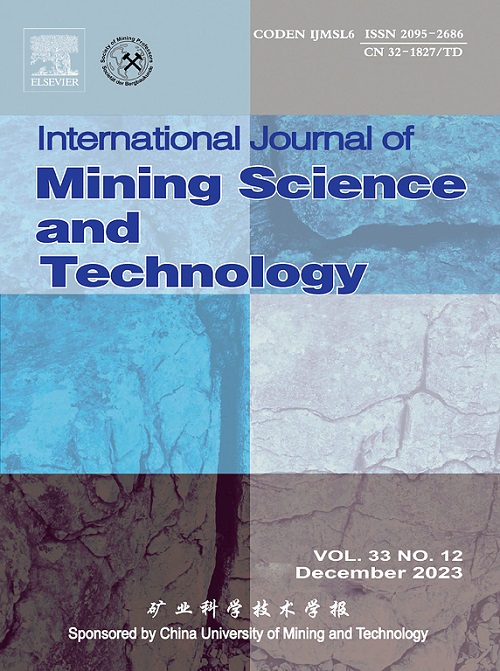Shear failure behaviors and degradation mechanical model of rockmass under true triaxial multi-level loading and unloading shear tests
IF 11.7
1区 工程技术
Q1 MINING & MINERAL PROCESSING
International Journal of Mining Science and Technology
Pub Date : 2024-10-01
DOI:10.1016/j.ijmst.2024.10.002
引用次数: 0
Abstract
The redistribution of three-dimensional (3D) geostress during underground tunnel excavation can easily induce to shear failure along rockmass structural plane, potentially resulting in engineering disasters. However, the current understanding of rockmass shear behavior is mainly based on shear tests under 2D stress without lateral stress, the shear fracture under 3D stress is unclear, and the relevant 3D shear fracture theory research is deficient. Therefore, this study conducted true triaxial cyclic loading and unloading shear tests on intact and bedded limestone under different normal stress σn and lateral stress σp to investigate the shear strength, deformation, and failure characteristics. The results indicate that under different σn and σp, the stress–strain hysteresis loop area gradually increases from nearly zero in the pre-peak stage, becomes most significant in the post-peak stage, and then becomes very small in the residual stage as the number of shear test cycles increases. The shear peak strength and failure surface roughness almost linearly increase with the increase in σn, while they first increase and then gradually decrease as σp increases, with the maximum increases of 12.9% for strength and 15.1% for roughness. The shear residual strength almost linearly increases with σn, but shows no significant change with σp. Based on the acoustic emission characteristic parameters during the test process, the shear fracture process and microscopic failure mechanism were analyzed. As the shear stress τ increases, the acoustic emission activity, main frequency, and amplitude gradually increase, showing a significant rise during the cycle near the peak strength, while remaining almost unchanged in the residual stage. The true triaxial shear fracture process presents tensile-shear mixture failure characteristics dominated by microscopic tensile failure. Based on the test results, a 3D shear strength criterion considering the lateral stress effect was proposed, and the determination methods and evolution of the shear modulus G, cohesion cjp, friction angle φjp, and dilation angle ψjp during rockmass shear fracture process were studied. Under different σn and σp, G first rapidly decreases and then tends to stabilize; cjp, φjp, and ψjp first increase rapidly to the maximum value, then decrease slowly, and finally remain basically unchanged. A 3D shear mechanics model considering the effects of lateral stress and shear parameter degradation was further established, and a corresponding numerical calculation program was developed based on 3D discrete element software. The proposed model effectively simulates the shear failure evolution process of rockmass under true triaxial shear test, and is further applied to successfully reveal the failure characteristics of surrounding rocks with structural planes under different combinations of tunnel axis and geostress direction.
真三轴多级加卸载剪切试验下岩体剪切破坏行为及退化力学模型
地下隧道开挖过程中三维地应力的重新分布,容易诱发岩体结构面剪切破坏,造成潜在的工程灾害。然而,目前对岩体剪切特性的认识主要是基于二维应力下无侧应力的剪切试验,三维应力下的剪切断裂尚不清楚,相关的三维剪切断裂理论研究不足。为此,本研究在不同的正应力σn和侧向应力σp下,对完整灰岩和层状灰岩进行真三轴循环加卸载剪切试验,研究其抗剪强度、变形和破坏特征。结果表明:在不同σn和σp条件下,随着剪切试验循环次数的增加,应力-应变迟滞回线面积由峰前阶段的接近零逐渐增大,峰后阶段变为最显著,剩余阶段变为极小;剪切峰值强度和破坏表面粗糙度随σn的增加呈线性增加,随σp的增加先增加后逐渐减小,强度和粗糙度分别增加12.9%和15.1%。剪切残余强度随σn的增加几乎呈线性增加,但随σp的增加变化不显著。基于试验过程中的声发射特征参数,分析了试样的剪切断裂过程和细观破坏机理。随着剪切应力τ的增大,声发射活度、主频率和幅值逐渐增大,在峰值强度附近表现为显著上升,而在残余阶段基本保持不变。真三轴剪切断裂过程呈现以微观拉伸破坏为主的拉剪混合破坏特征。在试验结果的基础上,提出了考虑侧向应力效应的三维抗剪强度准则,研究了岩体剪切破坏过程中剪切模量G、黏聚力cjp、摩擦角φjp和剪胀角ψjp的确定方法和演化规律。在不同σn和σp下,G先迅速减小后趋于稳定;Cjp、φjp、ψjp先快速上升至最大值,然后缓慢下降,最后基本保持不变。进一步建立了考虑侧向应力和剪切参数退化影响的三维剪切力学模型,并基于三维离散元软件开发了相应的数值计算程序。该模型有效模拟了真三轴剪切试验下岩体剪切破坏演化过程,并成功揭示了不同隧道轴线和地应力方向组合下围岩结构面破坏特征。
本文章由计算机程序翻译,如有差异,请以英文原文为准。
求助全文
约1分钟内获得全文
求助全文
来源期刊

International Journal of Mining Science and Technology
Earth and Planetary Sciences-Geotechnical Engineering and Engineering Geology
CiteScore
19.10
自引率
11.90%
发文量
2541
审稿时长
44 days
期刊介绍:
The International Journal of Mining Science and Technology, founded in 1990 as the Journal of China University of Mining and Technology, is a monthly English-language journal. It publishes original research papers and high-quality reviews that explore the latest advancements in theories, methodologies, and applications within the realm of mining sciences and technologies. The journal serves as an international exchange forum for readers and authors worldwide involved in mining sciences and technologies. All papers undergo a peer-review process and meticulous editing by specialists and authorities, with the entire submission-to-publication process conducted electronically.
 求助内容:
求助内容: 应助结果提醒方式:
应助结果提醒方式:


